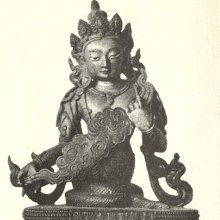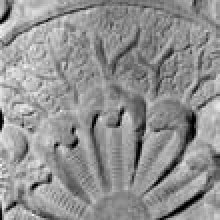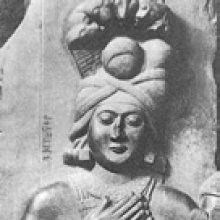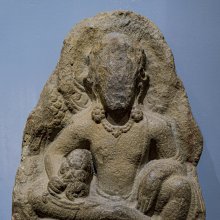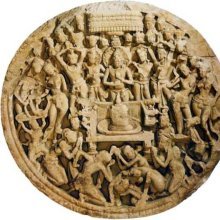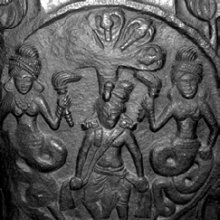Nagaraja, Nāgarāja, Naga-raja, Nāgarājā: 19 definitions
Introduction:
Nagaraja means something in Buddhism, Pali, Hinduism, Sanskrit, Hindi. If you want to know the exact meaning, history, etymology or English translation of this term then check out the descriptions on this page. Add your comment or reference to a book if you want to contribute to this summary article.
Alternative spellings of this word include Naagraj.
Images (photo gallery)
(+6 more images available)
In Hinduism
Natyashastra (theatrics and dramaturgy)
Source: Wisdom Library: Nāṭya-śāstraNāgarāja (नागराज) is the Sanskrit name for a deity (“King of the nāgas”) to be worshipped during raṅgapūjā, according to the Nāṭyaśāstra 3.1-8. Accordingly, the master of the dramatic art who has been initiated for the purpose shall consecrate the playhouse after he has made obeisance (e.g., to Nāgarāja).

Natyashastra (नाट्यशास्त्र, nāṭyaśāstra) refers to both the ancient Indian tradition (shastra) of performing arts, (natya—theatrics, drama, dance, music), as well as the name of a Sanskrit work dealing with these subjects. It also teaches the rules for composing Dramatic plays (nataka), construction and performance of Theater, and Poetic works (kavya).
Shaivism (Shaiva philosophy)
Source: Google Books: Manthanabhairavatantram (shaivism)Nāgarāja (नागराज) refers to the “king of the snakes” and represents one of the attributes of Svacchanda, according to the Śrīmatottara-tantra, an expansion of the Kubjikāmatatantra: the earliest popular and most authoritative Tantra of the Kubjikā cult. Accordingly, “O goddess, Svacchanda is in the middle, within the abode of the triangle. Very powerful, he has five faces with three times five flaming eyes. [...] O fair lady, my attributes—trident, dagger, sword, the king of the snakes [i.e., nāgarāja], and rosary—adorn the right (arms). O beloved, a skull, double-headed drum, javelin, noose and goad—(these) are my divine, brilliant and very auspicious weapons that (are held) in the left (hands). The king of snakes (hangs) on the shoulder and a garland of skulls hangs (from the neck). There is a necklace of scorpions around the throat and the ears are adorned with snakes. [...]”.

Shaiva (शैव, śaiva) or Shaivism (śaivism) represents a tradition of Hinduism worshiping Shiva as the supreme being. Closely related to Shaktism, Shaiva literature includes a range of scriptures, including Tantras, while the root of this tradition may be traced back to the ancient Vedas.
Purana and Itihasa (epic history)
Source: archive.org: Shiva Purana - English TranslationNāgarāja (नागराज) refers to the “Serpent-king” (i.e., king of Pātāla), according to the Śivapurāṇa 2.5.16 (“The battle of the gods”).—Accordingly, as Brahmā and the Gods eulogized Viṣṇu: “[...] The sun has been dislodged from his post. Similarly the moon and the fire too have been removed. The Serpent-king (nāgarāja) has been removed from Pātāla and Dharmarāja has been dispossessed. While men freely move about, the gods do not shine. We have sought refuge in you. Let measures for his annihilation be thought of. [...]”.

The Purana (पुराण, purāṇas) refers to Sanskrit literature preserving ancient India’s vast cultural history, including historical legends, religious ceremonies, various arts and sciences. The eighteen mahapuranas total over 400,000 shlokas (metrical couplets) and date to at least several centuries BCE.
In Buddhism
Mahayana (major branch of Buddhism)
Source: Wisdom Library: Maha Prajnaparamita SastraNāgarāja (नागराज) refers to Kings of the Nāga according to the 2nd century Mahāprajñāpāramitāśāstra chapter XLVI.—Accordingly, “just as the Nāga kings (Nāgarāja) and the birds with golden wings (Garuḍa), despite their great power (anubhāva) and their power of transformation, belong to the animal destiny (tiryaggati), so the Asuras belong to a good destiny, but one which is of lower order. [...] The Nāga kings (nāgarāja) and the birds with golden wings, even though they too enjoy bliss, walk horizontally and resemble animals in shape; this is why they are classed in the animal destiny”.
Source: De Gruyter: A Buddhist Ritual Manual on AgricultureNāgarāja (नागराज) refers to a “snake-king”, according to the 2nd-century Meghasūtra (“Cloud Sutra”) in those passages which contain ritual instructions.—Accordingly, “He who desires a mighty rain must perform this rite ‘the great-cloud-circle’ in an open space, overspread by a blue canopy, shaded by a blue banner, on a clear spot of earth; [...] then the prophet of the Law, after having painted towards the four quarters with liquid cow-dung on a reed, in the eastern quarter three hastas high must depict the snake-king (nāgarāja) called Triśīrṣaka, with cow-dung: in the southern quarter him called Pañcaśīrṣaka five hastas high; in the western, seven hastas high, Saptaśīrṣaka; in the northern, Navaśīrṣaka, nine hastas high. [...]”.

Mahayana (महायान, mahāyāna) is a major branch of Buddhism focusing on the path of a Bodhisattva (spiritual aspirants/ enlightened beings). Extant literature is vast and primarely composed in the Sanskrit language. There are many sūtras of which some of the earliest are the various Prajñāpāramitā sūtras.
Tibetan Buddhism (Vajrayana or tantric Buddhism)
Source: OSU Press: Cakrasamvara SamadhiNāgarāja (नागराज) refers to the “king of serpents”, according to the Guru Mandala Worship (maṇḍalārcana) ritual often performed in combination with the Cakrasaṃvara Samādhi, which refers to the primary pūjā and sādhanā practice of Newah Mahāyāna-Vajrayāna Buddhists in Nepal.—Accordingly, “[...] On the Bharata continent, in northern Pāñcāla, at the feet of the Himalayas, In the land of Vāsuki, the seat of Upachandoha, in the holy land Āryāvarta, In the home of Karkoṭaka king of serpents (karkoṭaka-nāgara-ājālaya), In the great lake Nāgavāsa, Site of Śrī Svayambhū Caitya, inhabited by Śrī Guyeśvarī Prajñāpāramita, In the land of the Nepal mandala, in the form of the Śrī Saṃvara mandala, In the same land of Sudurjayā, [...]”.,

Tibetan Buddhism includes schools such as Nyingma, Kadampa, Kagyu and Gelug. Their primary canon of literature is divided in two broad categories: The Kangyur, which consists of Buddha’s words, and the Tengyur, which includes commentaries from various sources. Esotericism and tantra techniques (vajrayāna) are collected indepently.
Languages of India and abroad
Pali-English dictionary
Source: BuddhaSasana: Concise Pali-English Dictionarynāgarāja : (m.) king of the Nāgas.
Source: Sutta: The Pali Text Society's Pali-English DictionaryNāgarājā refers to: king of the Nāgas, i.e. serpents J. II, 111; III, 275; Sn. 379 (Erāvaṇa, see detail SnA 368); DhA. I, 359; III, 231, 242 sq. (Ahicchatta); IV, 129 sq. (Paṇṇaka);
Note: nāgarājā is a Pali compound consisting of the words nāga and rājā.

Pali is the language of the Tipiṭaka, which is the sacred canon of Theravāda Buddhism and contains much of the Buddha’s speech. Closeley related to Sanskrit, both languages are used interchangeably between religions.
Sanskrit dictionary
Source: DDSA: The practical Sanskrit-English dictionaryNāgarāja (नागराज).—
1) an epithet of Śeṣa.
2) a large elephant; अधस्तान्नागराजाय सोमायोर्ध्वं दिशं ददौ (adhastānnāgarājāya somāyordhvaṃ diśaṃ dadau) Hariv.
Derivable forms: nāgarājaḥ (नागराजः).
Nāgarāja is a Sanskrit compound consisting of the terms nāga and rāja (राज).
Source: Cologne Digital Sanskrit Dictionaries: Shabda-Sagara Sanskrit-English DictionaryNāgarāja (नागराज).—m.
(-jaḥ) Ananta, the chief of the Nagas. E. nāga, and rāja king.
Source: Cologne Digital Sanskrit Dictionaries: Benfey Sanskrit-English DictionaryNāgarāja (नागराज).—1. the king of the serpents, [Kathāsaritsāgara, (ed. Brockhaus.)] 22, 209. 2. a great elephant, Mahābhārata 4, 1679.
Nāgarāja is a Sanskrit compound consisting of the terms nāga and rāja (राज).
Source: Cologne Digital Sanskrit Dictionaries: Cappeller Sanskrit-English DictionaryNāgarāja (नागराज).—[masculine] the same, also king of the elephants, i.e. a large elephant.
Source: Cologne Digital Sanskrit Dictionaries: Aufrecht Catalogus CatalogorumNāgarāja (नागराज) as mentioned in Aufrecht’s Catalogus Catalogorum:—of the Ṭāka family, son of Jālapa, grandson of Vidyādhara (Bhr. p. 198): Śataka. K. 60. B. 2, 88. Pheh. 6. Poona. 237. Bhāvaśataka kāvya. Śṛṅgāraśataka.
Source: Cologne Digital Sanskrit Dictionaries: Monier-Williams Sanskrit-English Dictionary1) Nāgarāja (नागराज):—[=nāga-rāja] [from nāga] m. idem, [ib.] (also jan)
2) [v.s. ...] a large or noble elephant, [ib.]
3) [v.s. ...] Name of an author (also -keśava)
Source: Cologne Digital Sanskrit Dictionaries: Yates Sanskrit-English DictionaryNāgarāja (नागराज):—[nāga-rāja] (jaḥ) 1. m. Ananta, the king of the Nāgas.
[Sanskrit to German]
Sanskrit, also spelled संस्कृतम् (saṃskṛtam), is an ancient language of India commonly seen as the grandmother of the Indo-European language family (even English!). Closely allied with Prakrit and Pali, Sanskrit is more exhaustive in both grammar and terms and has the most extensive collection of literature in the world, greatly surpassing its sister-languages Greek and Latin.
Hindi dictionary
Source: DDSA: A practical Hindi-English dictionaryNāgarāja (नागराज) [Also spelled naagraj]:—(nm) the mythological king of snakes called [śeṣanāga]; a huge snake.
...
Kannada-English dictionary
Source: Alar: Kannada-English corpusNagarāja (ನಗರಾಜ):—[noun] = ನಗಪ [nagapa].
--- OR ---
Nāgarāja (ನಾಗರಾಜ):—[noun] Ādiśeṣa, the king of serpents.
Kannada is a Dravidian language (as opposed to the Indo-European language family) mainly spoken in the southwestern region of India.
See also (Relevant definitions)
Starts with: Nagarajadhara, Nagarajakeshava, Nagarajalaya, Nagarajan, Nagarajana, Nagarajanataka, Nagarajapaddhati, Nagarajaparshad, Nagarajasana, Nagarajashataka, Nagarajay, Nagarajaya.
Ends with: Anavataptanagaraja, Ganganagaraja, Mahanagaraja, Pannagaraja, Sitanagaraja.
Full-text (+149): Nakhaka, Nanda, Nardana, Nagarajanataka, Nagarajapaddhati, Nagarajashataka, Baladeva, Sagaranagarajaparipriccha, Citraksha, Amratirtha, Sagaraparipriccha, Tidha, Nagarajaya, Upananda, Ganganagaraja, Sagarapala, Bhavashataka, Nagarajay, Buddhika, Svarapuranjaya.
Relevant text
Search found 36 books and stories containing Nagaraja, Nāgarāja, Naga-raja, Nāga-rāja, Nāgarājā, Nāga-rājā, Nagarāja, Naga-rāja; (plurals include: Nagarajas, Nāgarājas, rajas, rājas, Nāgarājās, rājās, Nagarājas). You can also click to the full overview containing English textual excerpts. Below are direct links for the most relevant articles:
Maha Prajnaparamita Sastra (by Gelongma Karma Migme Chödrön)
I. Recollection of the Buddha (2): The miracles of his birth < [Part 2 - The Eight Recollections according to the Abhidharma]
Appendix 2 - Ahicchatra (capital of northern Pañcala, present Ramnagar) < [Chapter V - Rājagṛha]
Appendix 1 - Story of the nāga-king Elapatra < [Chapter XL - The Four Fearlessnesses and the Four Unobstructed Knowledges]
Tibetan tales (derived from Indian sources) (by W. R. S. Ralston)
Chaitanya Bhagavata (by Bhumipati Dāsa)
Verse 1.16.202 < [Chapter 16 - The Glories of Śrī Haridāsa Ṭhākura]
Verse 1.16.248 < [Chapter 16 - The Glories of Śrī Haridāsa Ṭhākura]
Verse 2.18.159 < [Chapter 18 - Mahāprabhu’s Dancing as a Gopī]
Amaravati Art in the Context of Andhra Archaeology (by Sreyashi Ray chowdhuri)
Vidurapaṇḍita Jātaka < [Chapter 3 - Amarāvatī and the Formative Stage of the Buddhist Art]
The Nāga motif < [Chapter 5 - Impact of Amarāvatī Art]
Mahāpaduma Jātaka < [Chapter 3 - Amarāvatī and the Formative Stage of the Buddhist Art]
Vastu-shastra (5): Temple Architecture (by D. N. Shukla)
Kavyamimamsa of Rajasekhara (Study) (by Debabrata Barai)
Part 2.3 - Genesis of Sāhitya-vidyā (literart criticism) < [Chapter 5 - Analyasis and Interpretations of the Kāvyamīmāṃsā]
Part 7.19 - Poetic conventions regarding to the Nāga and Sarpa < [Chapter 5 - Analyasis and Interpretations of the Kāvyamīmāṃsā]
Part 6.1b - Anyayoni (1): Pratibimbakalpa < [Chapter 5 - Analyasis and Interpretations of the Kāvyamīmāṃsā]
